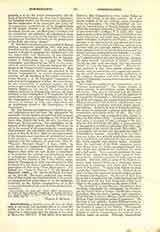

Commodianus, a Christian poet, the date of whose birth is uncertain, but generally placed at about the middle of the third century, or between the end of Diocletian‘s persecution and the issuing of the edict of Maxentius (305-11). It has lately been asserted, however, that Commodianus lived under Julian or even in the middle of the fifth century. He is not known outside of his own writings except through a notice by Gennadius, “De Viris Illustribus” (ch. xv), and the condemnation of Pseudo-Gelasius, who prohibits the reading of his books (“De Libris recipiendis et non recipiendis”, in Migne, P.L., LIX, 163) Gennadius seems to draw his information chiefly from the works themselves, and claims that Commodianus imitated Tertullian, Lactantius, and Papias. From two passages in his manuscripts it was gleaned that Cornmodianus came from Gaza in Palestine and had been invested with the episcopal dignity, but the first of these passages has a very uncertain meaning, and the second has been attributed to the mistake of a copyist. Commodianus declares that he is not a “doctor”, which has led to the belief that he was a layman. He styles himself “mendicant of Christ”, mendicus Christi, but that could also mean “one who implores Christ” or “one who begs for Christ”. What is certain, however, is that, after various religious experiences, such as associating with pagans and practising the occult sciences, and probably conforming to the religious doctrines and rites of the Jews, he adopted Christianity, having been converted by reading the Bible.
His works are a collection of “Instructions” and a “Carmen apologeticum”. The former consists of eighty acrostic, or abecedarian, essays, divided into two books. The plan of this work and the Biblical quotations introduced therein reveal the influence of St. Cyprian’s “Testimonia”. The first book is against the Jews and pagans, the second being addressed to different categories of the faithful: catechumens, baptized Christians, penitents, matrones, clerks, priests, and bishops. In parts its tone is decidedly satirical. The author is manifestly engrossed with ethics, and recommends alms-deeds above all else. The “Carmen apologeticum” has a misleading title, thanks to Pitra, its first editor (1852). It may be divided into four parts: a preamble (I—88); a resume of the doctrine on God and Christ (89-578); a demonstration of the necessity of faith for salvation (579-790); and a description of the end of the world (791-1060). It is principally this picture that has made the name of Commodianus famous. According to it the Christians are a prey to a seventh persecution—the number is symbolical and indicates the last persecution. The Goths surprise and destroy Rome. Suddenly Nero, the Antichrist of the West, reappears, recaptures Rome from the Goths, associates himself with two Caesars and maltreats the Christians for three and a half years. Then a second Antichrist, the man from Persia, comes from the East, conquers Nero, burns Rome, establishes himself in Judea, and works wonders. But God, with an army of the blessed, advances from beyond Persia in a triumphal march; Antichrist is overcome, and Christ and His saints settle in Jerusalem. To learn what follows we must consult the “Instructions” (II, 1-4). First of all the elect rise from the dead and for 1000 years lead lives of pleasure and happiness. At the end of that time the world is destroyed by fire, Christ appears, and all the dead arise for the Last Judgment, which leads either to the joys of Paradise or the pains of Hell.
The sources of Commodianus’s information were the Bible—principally the Apocalypse, the Prophets, and the Fourth Book of Esdras—the Sibylline oracles, Tertullian, Minucius Felix, Cyprian, and Lactantius. From Terence, Lucretius, Horace, Cicero, and most of all from Virgil, he borrows modes of expression, His theology is not reliable; besides Millenarianism, he seems to profess Monarchianism and Patripassianism, two heresies in regard to the Trinity. His language is not only crude, but incorrect, and it would be a mistake to seek in Commodianus the origin of versification based on accent. Although unacquainted with prosody, he tries to write in dactylic hexameter, and succeeds in only 63 out of more than 2000 verses. However, his shortcomings are somewhat atoned for by his use of parallelism, rhyme, and the acrostic, and the regular division of his verses; moreover, in spite of its defects, his work is decidedly energetic. He has well-defined formulae, he conjures up magnificent pictures, and among the many artists and writers who have attempted a portrayal of the end of the world, Commodianus occupies a prominent place. His works have been edited by Ludwig (Leipzig, 1877-78) and by Dombart (Vienna, 1877, in “Corpus scriptorum eccles. latinorum”, XV). The poem against Marcie), attributed by some critics to Commodianus, is the work of an imitator.

